Buckwheat cultivation technology from sowing to harvesting
Buckwheat is a valuable cereal crop that is cultivated in many countries around the world. At home, in Northern India, it is called black rice or black wheat. The plant does not require special care. However, the technology for growing buckwheat has features that, if followed, yield high yields. We will tell you how buckwheat is grown, how it is “harvested” and which varieties are most often chosen.
What is buckwheat and where does buckwheat come from?
The diet of many people contains dishes from buckwheat. They have become a traditional addition to meat and poultry, a mandatory breakfast for children and the basis of diets.
Are buckwheat and buckwheat the same thing or not?
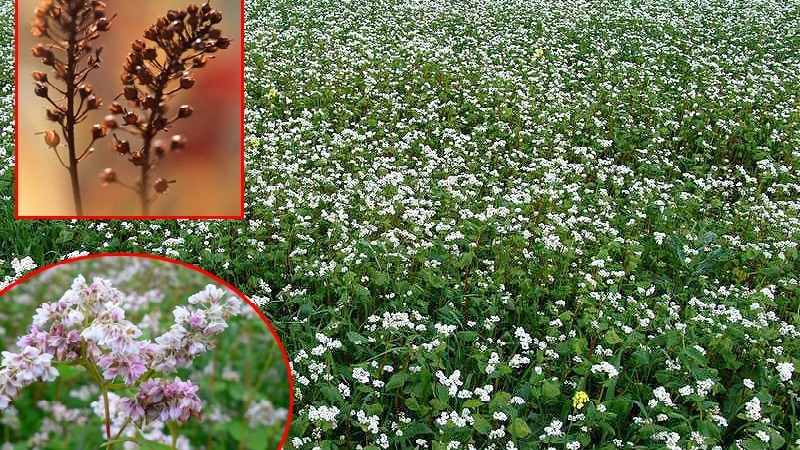
Buckwheat sativa is a herbaceous annual crop belonging to the Buckwheat family. Buckwheat is threshed buckwheat seeds that are eaten.
The plant can reach 1.5 m in height. It is a small bush with wide and fleshy leaves. Culture blooms abundantly, buckwheat fields are easily recognizable: white or pink lush inflorescences stand out against a dark green background.
It blooms in July, but fully ripens only in August. After flowering, buckwheat produces seeds. Inside each grain there is a kernel with a root and two folded cotyledons - this is buckwheat.
Buckwheat growing regions
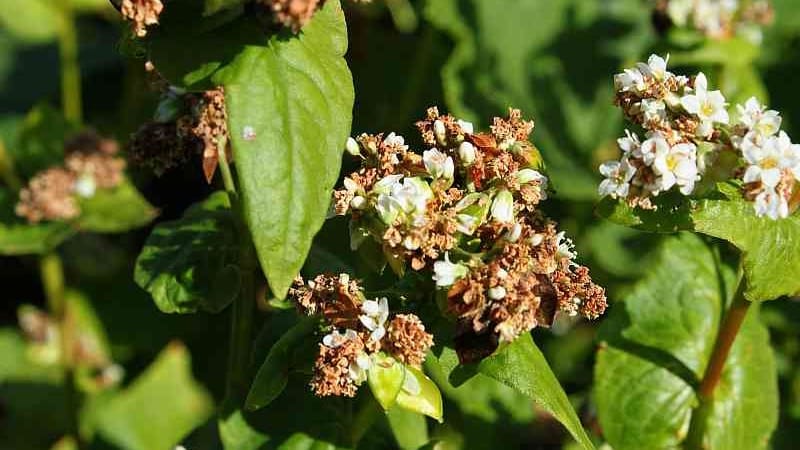
In Rus', buckwheat first appeared in the 9th-10th centuries, it was brought from Byzantium. Because of its “Greek origin,” this plant received its name.
In Russia, the largest areas of buckwheat are sown in Transbaikalia, Southern Siberia, and the Far East. In these regions, the crop grows on moist, fertile soils, surrounded by forests that protect the plantings from weathering moisture from the soil. The most suitable growing conditions are in the Volga region, the Urals, and southern Russia.
Varieties
More than 60 plants are cultivated on the territory of the Russian Federation varieties buckwheat We offer the characteristics of the most popular ones.
Bogatyr
Created at the Oryol Experimental Station. Valuable for quality and most common in production. Bogatyr is suitable for cultivation in almost the entire European part of the country with the exception of the north and southwest.
The plants are relatively tall - 70-100 cm with average resistance to lodging and drought. The variety is mid-season and requires heat. The grain is large, uniform in size, with a high grain yield. The porridge has a crumbly consistency.
Bolshevik-4
Created at the Institute of Plant Developmental Biology of the Russian Academy of Sciences. Plants are tall (up to 1 m), powerful, leafy. The fruits are large and smooth. When processing grain, the variety is characterized by a grain yield of up to 86%.
Bolshevik-4 is a medium-ripening variety; the growing season lasts from 68 to 78 days. Resistant to cold, lodging and grain shedding. Intended for cultivation in the southern regions of the central black earth zone and the North Caucasus.
Vlada
The plant is characterized by branching, resistance to lodging and seed shedding. Sowing work is carried out early, avoiding delays, otherwise crop losses are possible.
On average, 16.5 centners are removed from 1 hectare. The growing season of the plant is about 83 days. Cereal yield is 75.6%.
Dikul
Originator: All-Russian Research Institute of Legumes and Cereals. The variety is mid-season, zoned since 1999. The plant is distinguished by a low-growing stem (70-90 cm) with a light green color and weak pubescence. The leaves are small, heart-shaped, green. The grain is elongated, brown, medium size.
Ripening period - 2.5 months. Dikul is considered a high-yielding variety. The average is 16.1 c/ha, the maximum is 25.8 c/ha.
Chokeberry
The variety is early ripening, the growing season is no more than 75 days. The crop is tall (about 100 cm), branched. It blooms profusely, amicably, with white flowers. The plant has average resistance to lodging. When agrotechnical recommendations are followed, it gives a high yield on any soil in almost all climatic zones.
Landing dates
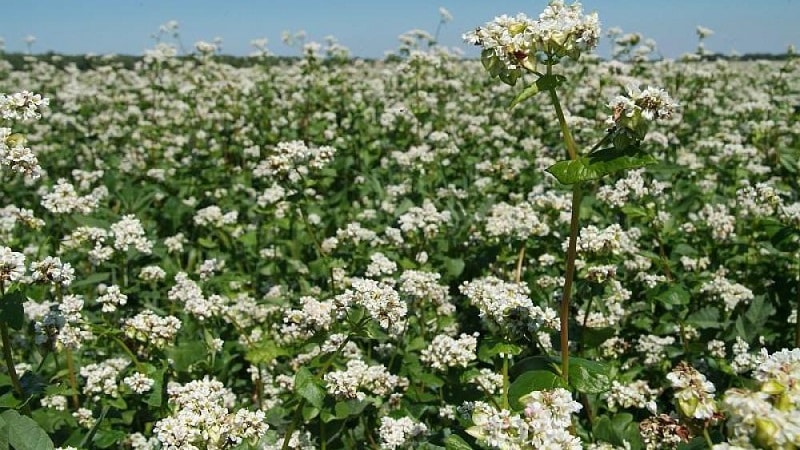
Buckwheat is sensitive to low temperatures: at -1°C the inflorescences, leaves and stems are damaged, at -6°C the plant dies. Therefore, sowing work begins when there is confidence that there will be no return frosts.
When is the best time to sow this crop? The sowing time for buckwheat is set in accordance with the average air temperature during the period of flowering and grain filling, which usually occurs 30-40 days after germination and lasts at least a month. During this period, buckwheat needs moderate air temperatures (within +25°C during the day). From the second half of May to the beginning of June is the optimal time for sowing.
Crop rotation rules
To obtain high yields, buckwheat is sown in fertile, weed-free fields. Row-crop fields where potatoes, sugar beets, and corn were grown are suitable for growing the crop.
Winter grains, flax, lupine, as well as leguminous crops are considered good predecessors, which create the most nutritious soil for the plant, accumulating nitrogen in it. Spring grains, sunflower, and sorghum are less suitable.
Important! You cannot sow buckwheat in fields where millet, oats, barley, or potatoes affected by nematodes were grown (in this case, the buckwheat yield will be significantly reduced).
Preparing for landing
When choosing a place for sowing, pay attention to the proximity of planting trees that will protect the crop from severe frosts and winds. The plantings are also home to pollinating insects, which are necessary during the flowering period.
The soil
The main preparation of the sown area is usually carried out in the fall. Perform soil peeling and fall plowing. Thanks to this treatment, moisture loss is reduced and the number of weeds is reduced.
In spring, work begins with early harrowing and 2-3 cultivations. When sowing early, the field is cultivated to a depth of 10-12 cm, the second cultivation is carried out after 1.5-2 weeks by another 6-9 cm, and pre-sowing - to the depth of seed placement. To speed up the germination of weed seeds and level the soil surface after treatment, rolling is carried out with ring-spur rollers.
Compared to cereals and other cereal crops, buckwheat builds up a large vegetative mass, so it is important to fertilize the plant in a timely and balanced manner in order to achieve high yields.
To form 1 quintal of grain add:
- nitrogen - 4.4 kg;
- phosphorus - 3 kg;
- potassium - 7.5 kg.
Planting material
For sowing, planting material adapted to the climatic conditions of the area is used. In addition, the yield increases if the seeds have been prepared:
- selection of large and heavy grains of the first class according to the sowing standard (diameter - 3.5-4 mm);
- dressing with fungicides for resistance to fungal and bacterial diseases;
- treatment with microfertilizers containing molybdenum ammonium or boric acid;
- drying - the seeds are scattered on a dry surface in a lighted, dry room and stirred periodically.
Sowing technology
Two methods are used:
- Broad-row — with row spacing of 45-60 cm (row-crop seeders). Used when sowing mid- and late-ripening varieties on highly fertile fertilized soils. The seed rate is about 50 kg/ha (2-3 million grains).
- Private — with row spacing of 15 cm (row seeders). The method is used when sowing early varieties on light and non-saline soils with low fertility. Norm - about 90 kg/ha (3-5 million pieces)
The depth of seed placement depends on the type of soil. On clay, heavy, prone to swimming - from 3 to 5 cm. On cultivated, well-groomed areas - 6 cm. When the soil is dry, the seeds are buried even lower - up to 8 cm.
Further care
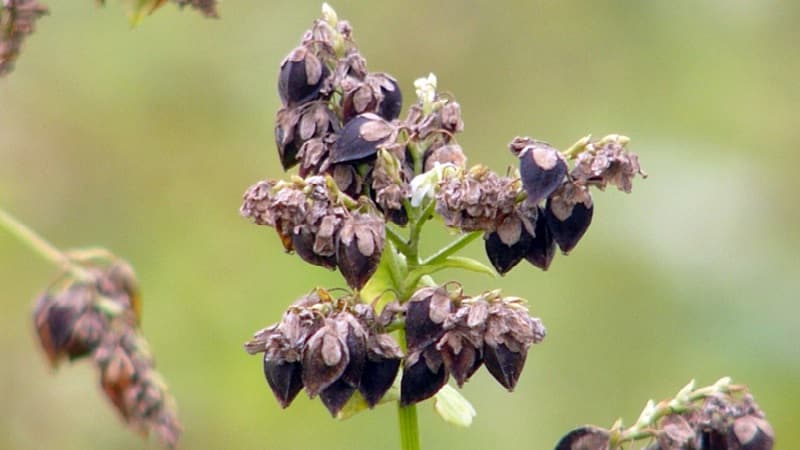
Depending on what stage of the growing season the buckwheat is in, it requires different care measures.
Watering
At the time of sowing and emergence of seedlings, the plant has enough soil moisture (25 mm). To preserve it, roll the crops. But from the beginning of the formation of buds, this need increases more than 2 times. It is important that at this moment and in the first half of flowering in the soil layer up to 0.5 m deep, the moisture reserve is 60-90 mm.
Top dressing
The crop responds well to fertilization. After the appearance of the first leaf and before budding, foliar fertilizing with nitrogen-containing fertilizers and growth regulators is recommended.At the beginning of flowering - boron superphosphate. After flowering, fertilizers are not applied.
Loosening
Loosen the soil after each watering and precipitation. The row spacing is loosened until the rows close together. This event removes the crust on the soil surface, which promotes the normal supply of moisture and oxygen to the root system.
Protection from diseases
Significant yield losses of this valuable cereal, honey and fodder crop are caused by diseases of various etiologies and harmful insects.
Late blight
It appears as brown spots, most often on buckwheat seedlings. During the period of flowering and fruiting of the crop, the disease causes complete browning and death of leaves, flowers and young fruits. Treatment is carried out with 1% Bordeaux mixture.
Downy mildew
At the beginning of flowering, yellowish, blurry oily spots appear on the leaves. To combat the fungus, use a suspension of colloidal sulfur (1%).
Gray rot
External signs of the disease appear on seedlings and adult plants in the form of brownish spots on the root collar, leaves, stems and inflorescences, which rot and become covered with a gray coating in wet weather. Plantings are sprayed with Bordeaux mixture (1%) or other copper-containing product.
Pest Control
Harmful insects interfere with the growth of a healthy crop: aphids, buckwheat fleas, and weevils. On the affected plant, the leaves curl, become deformed and die. Crops are treated with systemic insecticides: “LF-Ultrafit”, “LF-Gumate List”.
Important! When growing buckwheat, limit the use of pesticides that poison and repel bees.
Harvest and storage
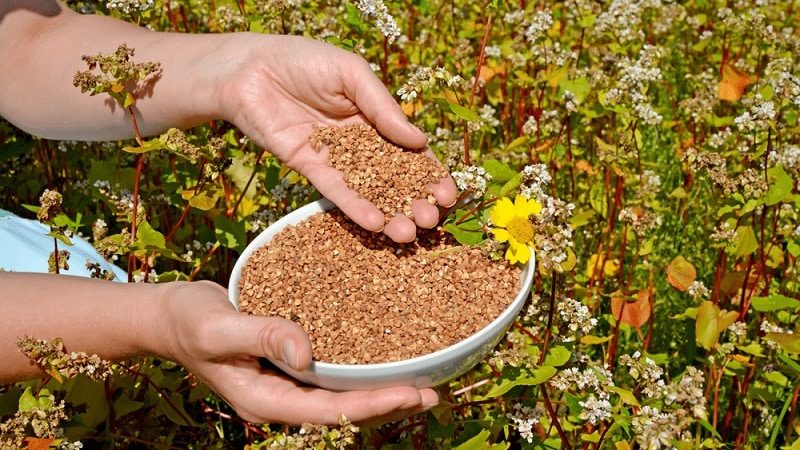
Buckwheat ripens 25-35 days after flowering. And they remove it after 70% of the fruits turn brown.Grains ripen unevenly, so it is almost impossible to wait until they reach full maturity. During this period, it is important to prevent plants from overgrowing, which will lead to the loss of a significant part of the harvest.
How to collect
The harvest is harvested in the morning or evening hours, when air humidity is maximum. When mowing, combines simultaneously perform initial processing of grain. Cleaning lasts no more than 5 days.
The optimal cutting height is 16-20 cm. When sowing in rows, mow along the rows. If buckwheat was sown according to the wide-row principle, mow it at an angle of 45°. This method significantly reduces crop losses.
Processing into buckwheat
Cleaning, drying and sorting are carried out after threshing; delay causes self-heating of the grain. Cleaning is carried out in three stages using special machines. If the grain is heavily contaminated, additional processing is carried out on pneumatic sorting tables.
Store seeds packed in bags in a dry and ventilated room with air humidity of no more than 15% on a wooden floor. At home, buckwheat is stored at a temperature of +5...+15°C and a humidity of 60% in a place protected from light for no more than a year.
Conclusion
When sowing crops, farmers follow recommendations on choosing a location, soil preparation, timing, depth of seed placement, and subsequently provide quality care. Following the rules of agricultural technology allows you to obtain sustainable buckwheat yields in all growing zones.